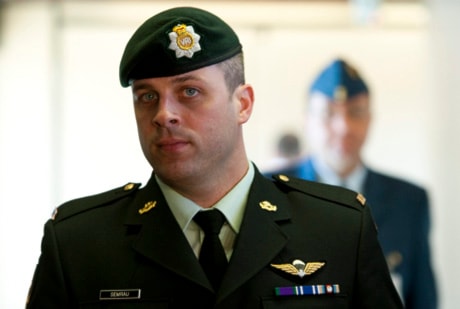GATINEAU, Que. — The first hint of a Canadian battlefield execution came from a stoned Afghan commander — near the end of a chaotic day-long offensive —and was dismissed, the commanding officer of Capt. Robert Semrau testified Thursday.
Semrau, 36, has pleaded not guilty to four charges, including second-degree murder, stemming from an October 2008 incident in Helmand Province when a badly wounded and disarmed insurgent was allegedly killed.
No body was ever recovered.
Maj. Steven Nolan, who was in charge of the Operation Mentor Liaison team assisting some 300 Afghan National Army soldiers that day, provided Semrau’s court martial with the first eyewitness account of the battle. The scene he painted was ugly.
Operating in close quarters between deep canals, with high foliage and cornfields limiting visibility, the offensive involved air strikes, repeated ambushes, an improvised explosive device (IED) strike that disabled an American unit and left a Canadian flank exposed, and Afghan army troops mistakenly firing on each other.
Nolan testified that Semrau radioed for instructions after reporting he had a severely wounded and disarmed insurgent, Nolan told the court at a Gatineau military complex.
Nolan said he instructed Semrau to “mentor the ANA (Afghan National Army) on providing first aid.”
Some five to seven minutes later, he said, he heard from the captain that the insurgent had died.
The prosecution alleges the ANA refused to treat the wounded insurgent and witnesses will say Semrau fired two shots from close range into his chest after telling a fellow soldier and interpreter to turn away so as not to witness the killing.
He was not charged until more than two months after the Oct. 19, 2008, battle.
Nolan testified that an Afghan lieutenant-colonel, for whom he had little respect and who had been chewing a “psycho-tropic” substance all day, made a strange sort of “comrade-in-arms comment” to him through an interpreter after the battle.
“My understanding of what he told me was ’one of your guys killed a Taliban’,” said Nolan.
Nolan testified he was “dismissive” of the comment, and was later told by the Afghan interpreter that the lieutenant-colonel was “joking.”
Given the circumstances of the chaotic battle, it was not clear from Nolan’s testimony why he found it strange that a Canadian soldier had killed one of the enemy.
The case, thought to be the first of its kind in Canada, is casting a spotlight on the training and conduct of the military in Canada’s most deadly military conflict since the Korean War.
It is also highlighting the murky mandate of the Operation Mentor Liaison Teams, or OMLTs, of which Semrau was a part.
